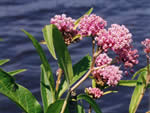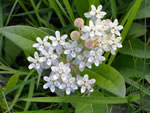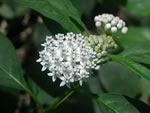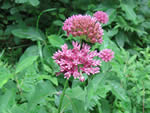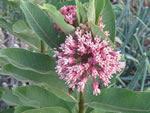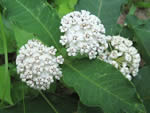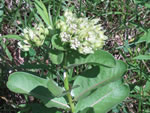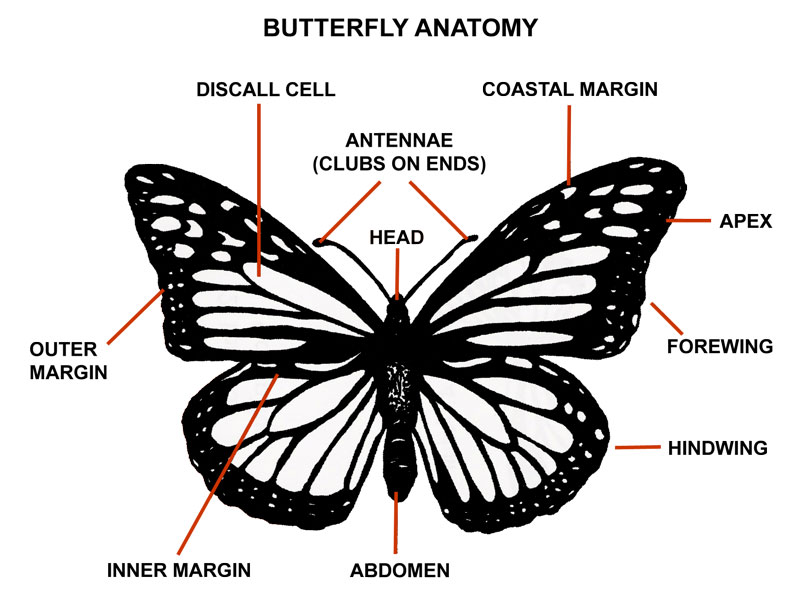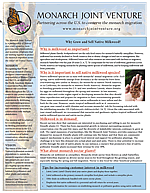Habitat Needs
Milkweeds and Nectar Sources
Whether it’s a field, roadside area, open area, wet area, or urban garden; milkweed and flowering plants are needed for monarch habitat. Adult monarchs feed on the nectar of many flowers, but they breed only where milkweeds are found.
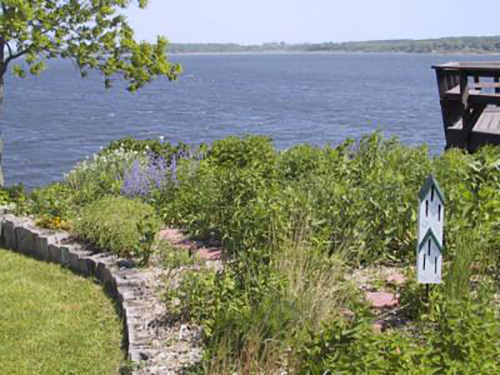 Lake Red Rock, Army Corps of Engineers, butterfly garden. Photo by Janet Mukai.
Lake Red Rock, Army Corps of Engineers, butterfly garden. Photo by Janet Mukai.
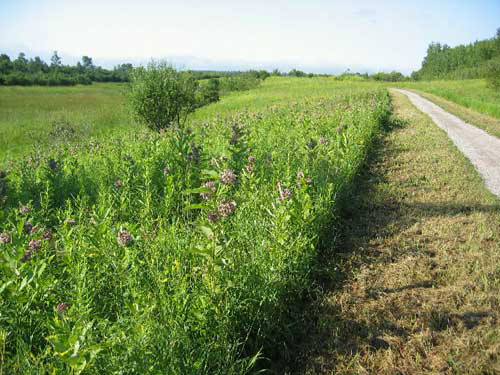 Knowlton Creek field, a monarch larva monitoring site in Duluth, Minnesota. Photo by Gail Gilland.
Knowlton Creek field, a monarch larva monitoring site in Duluth, Minnesota. Photo by Gail Gilland.
Importance of Milkweed
Many butterflies have a single plant required as a food source for their larval form called a host plant. Milkweed is the host plant for the monarch butterfly. Without milkweed, the larva would not be able to develop into a butterfly. Monarchs use a variety of milkweeds.
 Monarch larvae ,or caterpillars, feed exclusively on milkweed leaves. Photo by William Zittrich.
Monarch larvae ,or caterpillars, feed exclusively on milkweed leaves. Photo by William Zittrich.
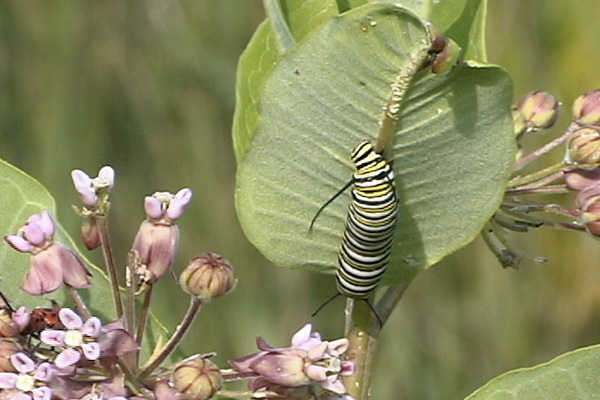 Photo by Dick Walton, Monarch Monitoring Project.
Photo by Dick Walton, Monarch Monitoring Project.
Different Types of Milkweed
Over 100 species of milkweed exist in North America, but only about one fourth of them are known to be important host plants for monarch butterflies.
From Plant of the Week
So Why Milkweed?
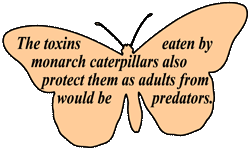
Protective Chemistry
Milkweed contains a a variety of chemical compounds that make monarch caterpillars poisonous to potential predators. Milkweeds contain a cardiac (heart) poison that is poisonous to most vertebrates (animals with backbones) but does not hurt the monarch caterpillar. Some milkweed species have higher levels of these toxins than others. Monarchs show preference to some milkweed species.
Protective Coloration
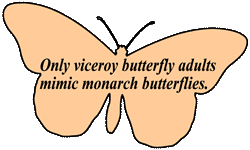
The adult monarch and monarch larvae are both brightly colored serving as a warning to potential predators that they are poisonous. Unsuspecting predators only need to taste a monarch butterfly or larva once to learn not to eat them again. Most animals quickly spit them out.
The Viceroy butterfly takes advantage of the protective coloration of the monarch butterfly by “mimicking”, or copying the colors and pattern of the monarch wing. With similar coloration, the viceroy can be mistaken for a monarch and is safe from these “educated” predators.
 Viceroy butterfly. Photo by Tom Barnes.
Viceroy butterfly. Photo by Tom Barnes.
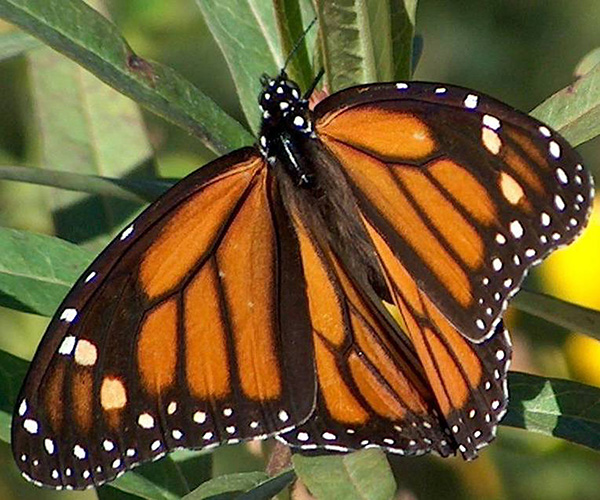 Monarch butterfly. Photo by Anne-Marie Conard.
Monarch butterfly. Photo by Anne-Marie Conard.
Note the pictures above and the butterfly anatomy diagram to the right. Viceroy butterflies are slightly smaller than monarchs and have a black line across the hindwing. The Viceroy has a single row of white dots in the black marginal band of the wing where the monarch has multiple white spots.
In Some Areas, Milkweeds are Considered to be Weeds
Milkweeds are listed in some states and provinces as noxious weeds. Certain milkweed species are considered noxious because they can be poisonous to cattle and other livestock. In some locations it is difficult to improve habitat for monarch butterflies because of the status of milkweed. Eradication of milkweed is a threat to the monarch butterfly.
There are additional threats to monarch butterflies, such as the use of herbicides and pesticides.
A Few Bad Milkweeds
There are a several native and introduced milkweed plants in the genus Cynanchum (swallow-worts) that are also eaten by monarchs. Swallow-worts have similar chemical properties to milkweeds in the genus Asclepias, that fool monarchs into laying eggs on them. Cynanchum species are not suitable food for monarch larvae. Caterpillars fail to develop into pupae when feeding on them. Please do not plant these milkweeds in your garden.
What’s the difference between noxious weeds and invasive plants?
Propagating Native Milkweeds for Restoring Monarch Butterfly Habitat
The number of monarch butterflies is rapidly declining. Milkweeds, which are the sole food source for monarch caterpillars, have also experienced a decline throughout the breeding range of this butterfly. Milkweeds can be grown from seeds or vegetatively from root cuttings or rhizomes. The International Plant Propagator's Society published this article in their Combined Proceedings, Volume 64, 2014.
Read the article about propagating milkweeds for restoring monarch butterfly habitat (PDF, 324 KB)…
Why Grow and Sell Native Milkweed?
The Monarch Joint Venture published the handout: “Why Grow and Sell Native Milkweed?”
This handout provides the public, gardeners, and plant growers and nurseries with a concise description of the importance of native milkweeds and their value to monarchs and to the plant industry! With tips about overcoming barriers to growing milkweed, resources for further reading and examples of native milkweeds for regions across the U.S., this new handout will be a valuable resource for anyone interested in the native milkweed industry. If you’re not a grower or nursery, consider bringing this resource to your local nursery manager if they aren’t already selling pesticide-free native milkweed!
Guidelines for Protecting California’s Butterfly Groves
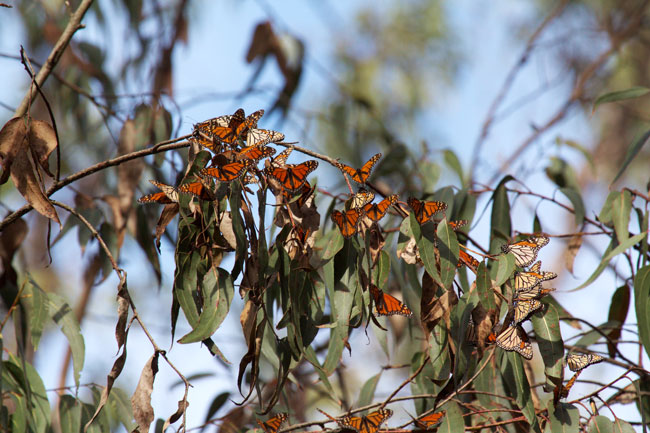 Monarchs Clustering on Eucalyptus at Woodlands Village, Nipomo, CA. Photo: Xerces Society, Carly Voight.
Monarchs Clustering on Eucalyptus at Woodlands Village, Nipomo, CA. Photo: Xerces Society, Carly Voight.
To guide land managers, landowners, and community groups who wish to implement management actions to protect, improve, and restore monarch overwintering habitat in California, the Xerces Society partnered with Stu Weiss of Creekside Center for Earth Observation to publish Protecting California’s Butterfly Groves: Management Guidelines for Monarch Butterfly Overwintering Habitat.
The guidelines provide an overview of the biology and conservation of western monarchs, step-by-step guidance for developing a site-specific management plan, and overall guidance on topics including tree management, shrub and forb management, and visitor and public access issues. The document also includes a list of monarch-attractive native nectar plants suitable for coastal areas. These guidelines will help site managers become familiar with overwintering monarch habitat needs and provides a roadmap to develop site-specific management plans to benefit monarchs in both the short- and long-term.
The new guidelines were developed through a combination of expert opinion and studies of monarch overwintering site requirements in Mexico and in California. The document benefited from the review and input of many knowledgeable biologists, including Mia Monroe (who initiated and still coordinates the Western Monarch Thanksgiving Count along with the Xerces Society), Francis Villablanca (a professor at Cal Poly and director of Monarch Alert), and Dan Meade (who has studied overwintering monarchs for decades). Protecting California’s Butterfly Groves replaces the previous overwintering sites guidance document (Conservation and Management Guidelines, published in 1993) and complements the 2016 report, State of the Monarch Butterfly Overwintering Sites in California, both published by the Xerces Society. Overwintering sites are complex, dynamic habitats and the understanding of their management is constantly evolving. We anticipate updating the guidelines in the light of additional research and experience of current restoration efforts.
Read Xerces blog about the guidelines…Nectar and Nectar Corridors
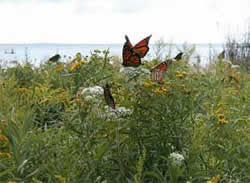 Monarchs nectaring on goldenrod and other wildflowers along the shoreline at Peninsula Point Lake Michigan. Photo by Anne Okonek.
Monarchs nectaring on goldenrod and other wildflowers along the shoreline at Peninsula Point Lake Michigan. Photo by Anne Okonek.
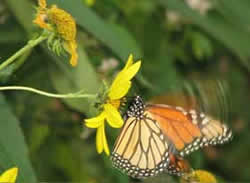 Nectaring monarch butterfly. Photo by Mark Garland.
Nectaring monarch butterfly. Photo by Mark Garland.
Adult monarchs feed on the nectar from flowers, which contain sugars and other nutrients. Unlike the larvae that only eat milkweeds, adult monarchs feed on a wide variety of nectar bearing flowers. They will visit many different kinds of flowers in their search for food.
An abundance of nectar sources is especially important for migrating monarchs. Monarchs that are preparing to migrate south to Mexico need to consume enough nectar to build up fat reserves. The food they eat before and during their migration south must not only power them through the long journey, but also must sustain them throughout the winter. Over-wintering monarchs feed very little or not at all. As monarchs migrate south, they will actually gain weight as they continue to feed on nectar bearing flowers.
In eastern North America, the monarchs leave the over wintering sites in the spring. Nectar is essential to making the journey to Texas. Nutrition from early spring nectar bearing wildflowers provides the energy and nutrients for these monarchs to develop their reproductive organs. When they arrive in Texas, they will breed and then die. As the new monarchs emerge they will make their way north. It will take three more generations of monarchs to complete their journey northward and then start the migratory cycle once again.
Nectar corridors are a series of habitat patches containing plants that flower at the appropriate times during the spring and fall migrations. These patches provide stopping-off points for the migrating butterflies to refuel and continue their journey. Having these islands of nectar sources is particularly important within large areas of urban and agricultural development. The discontinuous patches of nectar sources are “corridors” that monarchs will follow, like stepping-stones across a stream to complete their migration.
Monarch Butterflies Brochures
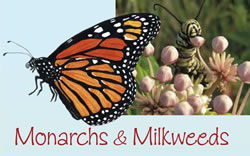
During spring and summer, monarchs breed throughout the U.S. and southern Canada. In the fall, adults of an eastern population migrate to Mexico, fl ying up to 3,000 miles. The following spring, these butter ies leave their overwintering sites and fly northward to lay their eggs on milkweeds and a few other plants in the dogbane family. In Florida, some non-migratory individuals remain and breed year-round.


